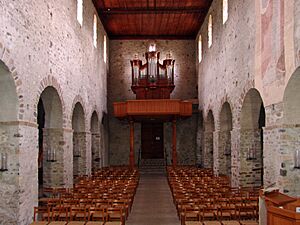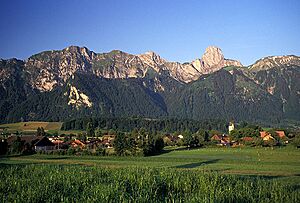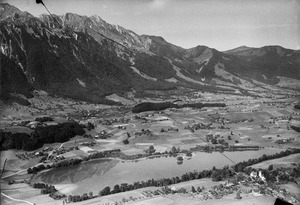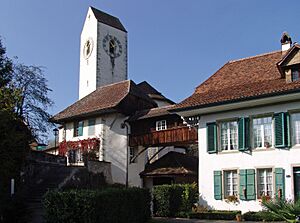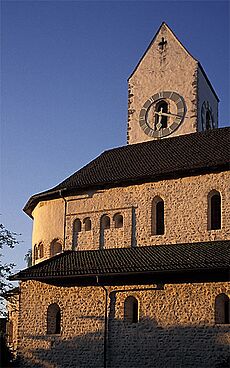Amsoldingen facts for kids
Quick facts for kids
Amsoldingen
|
||
|---|---|---|
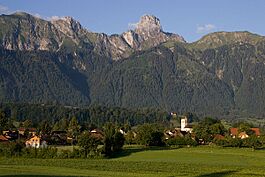
Amsoldingen beneath the Stockhorn.
|
||
|
||
| Country | Switzerland | |
| Canton | Bern | |
| District | Thun administrative district | |
| Area | ||
| • Total | 4.71 km2 (1.82 sq mi) | |
| Elevation | 637 m (2,090 ft) | |
| Population
(Dec 2020 )
|
||
| • Total | 800 | |
| • Density | 170/km2 (440/sq mi) | |
| Postal code |
3633
|
|
| Surrounded by | Höfen, Thierachern, Thun, Uebeschi, Zwieselberg | |
Amsoldingen is a small town, also called a municipality, located in the Thun area of the Bern canton in Switzerland. It's a peaceful place known for its history and beautiful natural surroundings.
Contents
Amsoldingen's Past: A Journey Through Time
Amsoldingen was first mentioned in official records way back in 1175. But people lived here much earlier than that!
Early Settlements and Ancient Villages
Archaeologists have found signs of a very old settlement near Schmittmoos. It might have been from the Neolithic period, also known as the New Stone Age. During the Bronze Age, there was a village on a hill called Bürgli.
The Famous Church and Castle
The most important historical building is the St. Mauritius Church. It's a special collegiate church, which means it used to have a group of priests living and working together. The first church was built around the year 700.
Later, in the 10th and 11th centuries, a new church was built. It was made from stones taken from old Roman ruins nearby. A castle and a village grew up around this church.
For a long time, the priests at the church managed the village. But as the city of Bern grew stronger, their power slowly faded. In 1484, the Pope allowed the group of priests to join a new, bigger group in Bern.
Amsoldingen in Modern Times
In 1798, France invaded Switzerland. Amsoldingen became part of a new district. Later, in 1803, it joined the Thun District. This district was changed in 2010, and Amsoldingen became part of the larger Verwaltungskreis Thun.
Today, Amsoldingen is a "commuter town." This means many people who live here travel to nearby Thun for work. New homes were built in the 1980s for the growing population. In 1990, many jobs were in farming and making things. Others were in services like shops or offices.
Exploring Amsoldingen's Geography
Amsoldingen covers an area of about 4.7 square kilometers. A big part of the land, about 60%, is used for farming. Forests cover about 22% of the area. Buildings and roads take up about 7.4% of the land.
Lakes and rivers make up about 8.5% of the area. A small part, about 1.5%, is land that can't be used for anything. Most of the water in the town is in its lakes.
Location and Nearby Areas
Amsoldingen is located about 5 kilometers (3 miles) from the city of Thun. The town includes the main village of Amsoldingen, which is next to the Amsoldingersee lake. There are also scattered farmhouses and small groups of homes called hamlets.
The local church area also includes the nearby towns of Höfen, Längenbühl, and Zwieselberg. Two beautiful lakes, Amsoldingersee and Uebeschisee, are right next to the town.
Amsoldingen's Coat of Arms
The town's official symbol, its coat of arms, shows a golden buckle on a blue background. This design represents Amsoldingen.
Who Lives in Amsoldingen? Demographics
Amsoldingen has a population of about 788 people (as of December 2012). Most people in Amsoldingen speak German. A very small number of people speak French, Albanian, or Italian.
Age Groups in Amsoldingen
In 2012, about 22% of the population were children and teenagers (under 19 years old). Adults (20-64 years old) made up about 58% of the population. Seniors (over 64 years old) made up about 19%.
Where People Come From
Many people living in Amsoldingen were born there, about 35%. Others were born in the same canton (Bern), and some were born elsewhere in Switzerland or outside of Switzerland.
Population Changes Over Time
The chart below shows how Amsoldingen's population has changed over many years:

Amsoldingen's Economy: How People Work
In 2011, Amsoldingen had a very low unemployment rate, meaning almost everyone who wanted a job had one. A total of 170 people worked in the town.
Types of Jobs in Amsoldingen
- Primary Sector: This includes jobs like farming. About 42 people worked in this area.
- Secondary Sector: These jobs involve making things, like in factories or construction. About 21 people worked here.
- Tertiary Sector: This covers service jobs, such as working in shops, restaurants, or healthcare. About 107 people worked in this sector.
Many people who live in Amsoldingen also work there. However, more people travel out of Amsoldingen for work than come into the town for jobs. Most people use a private car to get to work, while some use public transportation.
Taxes in Amsoldingen
Amsoldingen has some of the lowest tax rates in the canton of Bern. This means people living here pay less in local and canton taxes compared to many other places.
Important Heritage Sites in Amsoldingen
Amsoldingen is home to some very important historical places. The old collegiate Church of St Mauritius and the nearby Amsoldingen Castle are listed as Swiss heritage sites of national importance.
The Church of St Mauritius
The Amsoldingen Church is the largest Ottonian basilica in Switzerland. An Ottonian basilica is a type of church built during the time of the Ottonian emperors (around the 10th and 11th centuries). The heritage site includes the church itself, a dining hall (refectory), the sexton's house, and the castle.
Religion in Amsoldingen
According to a 2000 survey, most people in Amsoldingen belong to the Swiss Reformed Church. A smaller number are Roman Catholic. There are also people who belong to other Christian churches, or are Muslim, Buddhist, or Hindu. Some people do not belong to any church.
Learning and Education in Amsoldingen
Many adults in Amsoldingen have completed their high school education. A good number have also gone on to higher education, like university or a specialized college.
The School System
The Canton of Bern has a specific school system:
- One year of optional Kindergarten.
- Six years of Primary school.
- Three years of mandatory lower Secondary school. Students are grouped by their abilities.
- After secondary school, students can continue their education or start an apprenticeship (learning a trade on the job).
In the 2012-2013 school year, about 95 students attended classes in Amsoldingen. This included kindergarten and primary school students. Most students spoke German in class.
See also
 In Spanish: Amsoldingen para niños
In Spanish: Amsoldingen para niños





